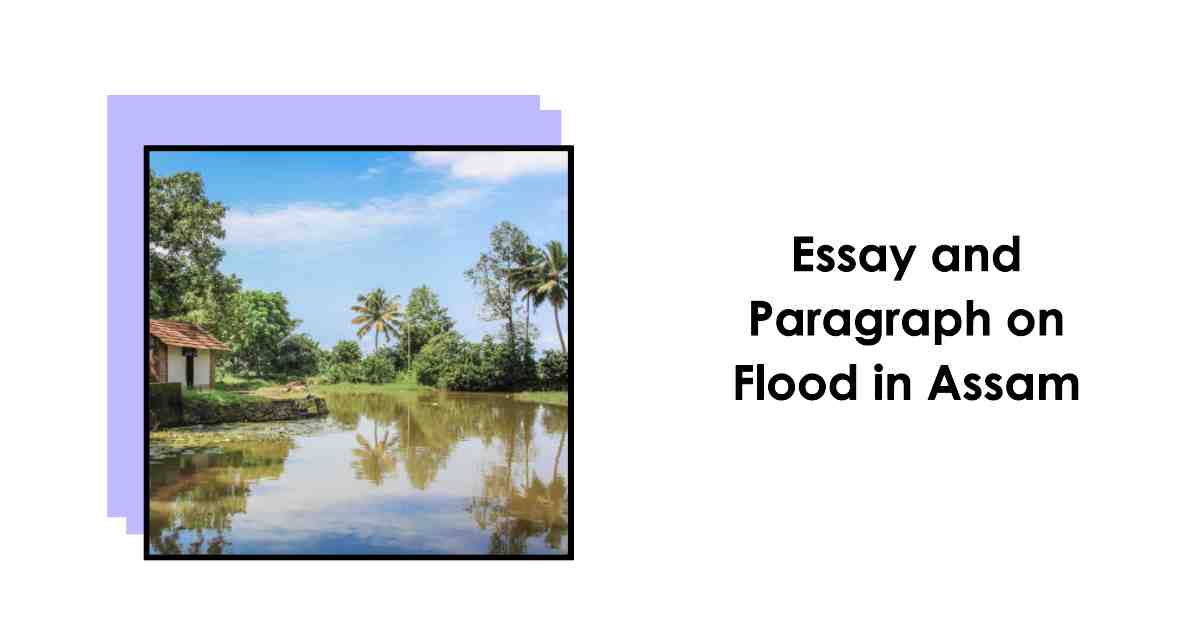
Here, we are presenting long and short Essay and Paragraph on Flood in Assam in English for students under word limits of 100 – 150 Words, 200 – 250 words, and 500 – 600 words. This topic is useful for students of classes 1, 2, 3, 4, 5, 6, 7, 8, 9, 10, 11, and 12 in English. These provided essays will help you to write effective essays, paragraphs, and speeches.
100 Words Essay and Paragraph on Flood in Assam
Introduction
In Assam, floods is a persistent issue that results in extensive destruction. Millions are impacted annually when the Brahmaputra River overflows as a result of intense rains.
Causes
A lot of rain during the monsoon is the main cause. Floods result from the melting of the Himalayan snow and an increase in the water level of the Brahmaputra River.
Effects
Livestock, property, and lives are lost in floods. They also interfere with daily living and cause water-borne illnesses.
Solutions
The impact can be reduced by erecting embankments, enhancing drainage, and putting early warning systems in place.
Conclusion
Assam floods demand quick attention. Reducing the harm requires the Brahmaputra River to be managed sustainably.
200 Words Essay and Paragraph on Flood in Assam
Introduction
Assamese floods are a frequent natural disaster that seriously disrupt the socioeconomic structure of the state. The wrath of the Brahmaputra River upends lives and wreaks immense havoc annually. This essay investigates the origins, effects, and possible remedies for this enduring problem.
Causes of Floods
Floods in Assam are primarily caused by the Brahmaputra River overflowing, which is made worse by excessive monsoon rainfall. This problem is exacerbated by the river’s unstable character, deforestation, and increasing urbanization. Seismic activity in the Himalayan region also contributes, resulting in landslides that obstruct river courses and trigger flash floods.
Impacts of Floods
The environment, property, and human lives are severely damaged by floods. They interfere with livelihoods, particularly with agriculture, which is the main industry in Assam. Due to frequent flooding in Kaziranga National Park, which is home to the critically endangered one-horned rhino, the floods also cause a loss of biodiversity.
Solutions
This problem requires a multifaceted solution to be solved. The construction of embankments and reservoirs, among other scientific river management techniques, can aid in regulating the river’s flow. Initiatives to reforest can lessen soil erosion, and thoughtful urban design can lessen the effects of growing urbanization. Early warning system implementation can also aid in preparing communities for approaching floods.
Conclusion
Although Assamese floods are a natural occurrence, human activity increases their effects. It is possible to lessen the devastating effects of these floods by concentrating on sustainable development and river management. By working together, society can turn this destructive force into a resource and turn hardship into opportunity.
500 Words Essay on Flood in Assam
Introduction
North-East Indian state of Assam is well known for its abundant biodiversity and dynamic culture. But it also suffers most from an annual threat: flooding. Assamese floods are a frequent calamity that severely disrupt the state’s socioeconomic structure.
The Geographical Context
Situated in the Brahmaputra Valley, Assam is encircled by the Meghalaya Plateau, the Patkai Range, and the Eastern Himalayas. The center of Assam is traversed by the Brahmaputra River, one of the world’s biggest rivers. Because of the topography of the area and the river’s heavy water flow, Assam is susceptible to yearly flooding.
The Causes of Floods in Assam
The monsoon rains that Assam receives from June to September are the main source of floods in the state. The Brahmaputra River overflows its banks due to tributaries, submerging the surrounding areas. The issue is made worse by the catchment areas’ deforestation, which increases surface runoff. Furthermore, landslides brought on by seismic activity in the Himalayan region frequently obstruct river courses and result in flash floods.
Impacts of the Floods
Assam’s floods have far-reaching consequences. They result in the loss of human lives and livestock, the destruction of infrastructure, and the displacement of people. Agricultural lands, which are the primary source of income for many people, are being submerged, resulting in food insecurity and economic hardship. The floods also endanger the state’s rich biodiversity, particularly in Kaziranga National Park, which is home to the endangered one-horned rhinoceros.
Management and Mitigation Strategies
The Assam State Disaster Management Authority (ASDMA), in collaboration with the National Disaster Management Authority (NDMA), has implemented a variety of flood-management strategies. These include embankment construction, river dredging, afforestation programs, and early warning systems. However, due to the magnitude of the problem and various implementation challenges, these strategies have not been entirely successful.
The Way Forward
An complete and long-term strategy is desperately needed to control floods in Assam. This strategy should combine non-structural elements like flood forecasts and community awareness campaigns with structural elements like reservoirs and embankments. A focus on ecological conservation and restoration is also necessary, given the close connection between floods and the environment. In addition, a proactive strategy that emphasizes risk mitigation and disaster preparedness should replace the reactive one.
Conclusion
The Assamese flood is a complicated problem with deep roots in the geographical and ecological dynamics of the state. Despite being a natural phenomenon, human activity has a significant impact on it. Therefore, to manage this yearly disaster and guarantee Assam’s socioeconomic resilience, a comprehensive, sustainable, and community-based approach is needed.
Also Read: Disaster Management Essay and Paragraph For Students of Class 5 to 12